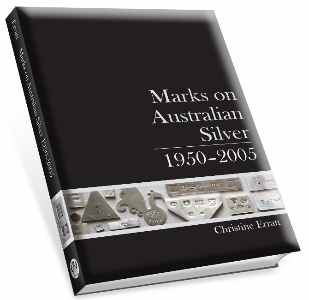by
Christine Erratt
(click on photos to enlarge image)
MARKS ON AUSTRALIAN SILVER
There is no register of the makersí marks applied to
silverware in Australia as Australia does not have a hallmarking
system.
When the idea came to me in 2002 to document the makersí marks
of contemporary Australian silversmiths, little did I realise
what an exciting project I was embarking on. Now, eight years
later, my book, Marks on Australian Silver 1950-2005, is
published. ISBN 978 0 646 52327 9

|
The fifty five years
covered in this book saw an era of great change in
Australia. A few manufacturing companies, which had
managed to survive the Great Depression and the
Second World War, were essentially the sole
silverware producers during the 1950s. Slowly
education of silversmiths changed from trade
apprenticeships to the domain of the art schools and
design schools. The era of the studio silversmith
evolved.
There are close to 600 marks recorded
photographically in the book. These represent the
marks of 315 makers and retailers. The vast majority
are individual craftsmen; some are retailers; and a
few are manufacturing companies.
With the freedom of no mandatory marking system,
Australian silversmiths have been able to decide if
they wished to mark their work and to design their
own makersí marks. Most use their initials or full
names, with or without secondary marks. Secondary
marks often indicate the home town or State of the
silversmith. Some silversmiths only use symbols. In
a country of unique fauna it is not surprising to
find some represented as makersí marks, such as the
kangaroo, the emu, the platypus and even the dingoís
paw print.
|
I documented all the marks photographically. This was quite
a challenge in itself. Silversmiths were asked to supply me with
samples of their makersí marks on pieces of metal. Some samples
were as narrow as 2mm (one thirteenth of an inch). At the
opposite end of the scale was a brass plate 126mm square (nearly
5 inches square) supplied by a manufacturing company with all
its own marks as well as its retail customersí marks.
After several years of research, I decided that appropriate
information about the makers would be an inclusion in the book
which would significantly benefit the reader. This has added 150
pages to the book and turned out to be very worthwhile.
I have also included sixteen pages of colour plates and four
pages of black and white images with a total of 60 beautiful
silverware objects. One of the B&W pages is a series of images
showing the stages of hand raising two beakers from the original
flat silver discs.
A glossary of terms is included, as is a recommended reading
list and an index.
I trust this book will be useful and interesting for many, not
only now but also well into the future as contemporary
silverware objects of today become the heirloom treasures of
tomorrow.
In the Foreword, Emeritus Professor Ray Stebbins, the inaugural
Professor of Gold and Silversmithing at RMIT University,
Melbourne states: For the foreseeable future this invaluable
compilation of Australian marks on silver will serve as the
principal identification resource for connoisseurs, academics,
curators and students.
|
Christine Erratt
- 2010 -
|
Christine Erratt, member of ASCAS since 2004, is the
author of Marks on Australian Silver and self-published
the books under the Australian business name of Parker Press (ABN
15 192 003 086).
The book can be purchased online at
www.parkerpressbooks.com.au and is offered to ASCAS members
at the discount price of AUD$90 (normal price $AUD120) plus
postage and handling (quote your ASCAS membership).
|
|
 ASSOCIATION OF SMALL COLLECTORS OF ANTIQUE SILVER
ASSOCIATION OF SMALL COLLECTORS OF ANTIQUE SILVER ASSOCIATION OF SMALL COLLECTORS OF ANTIQUE SILVER
ASSOCIATION OF SMALL COLLECTORS OF ANTIQUE SILVER